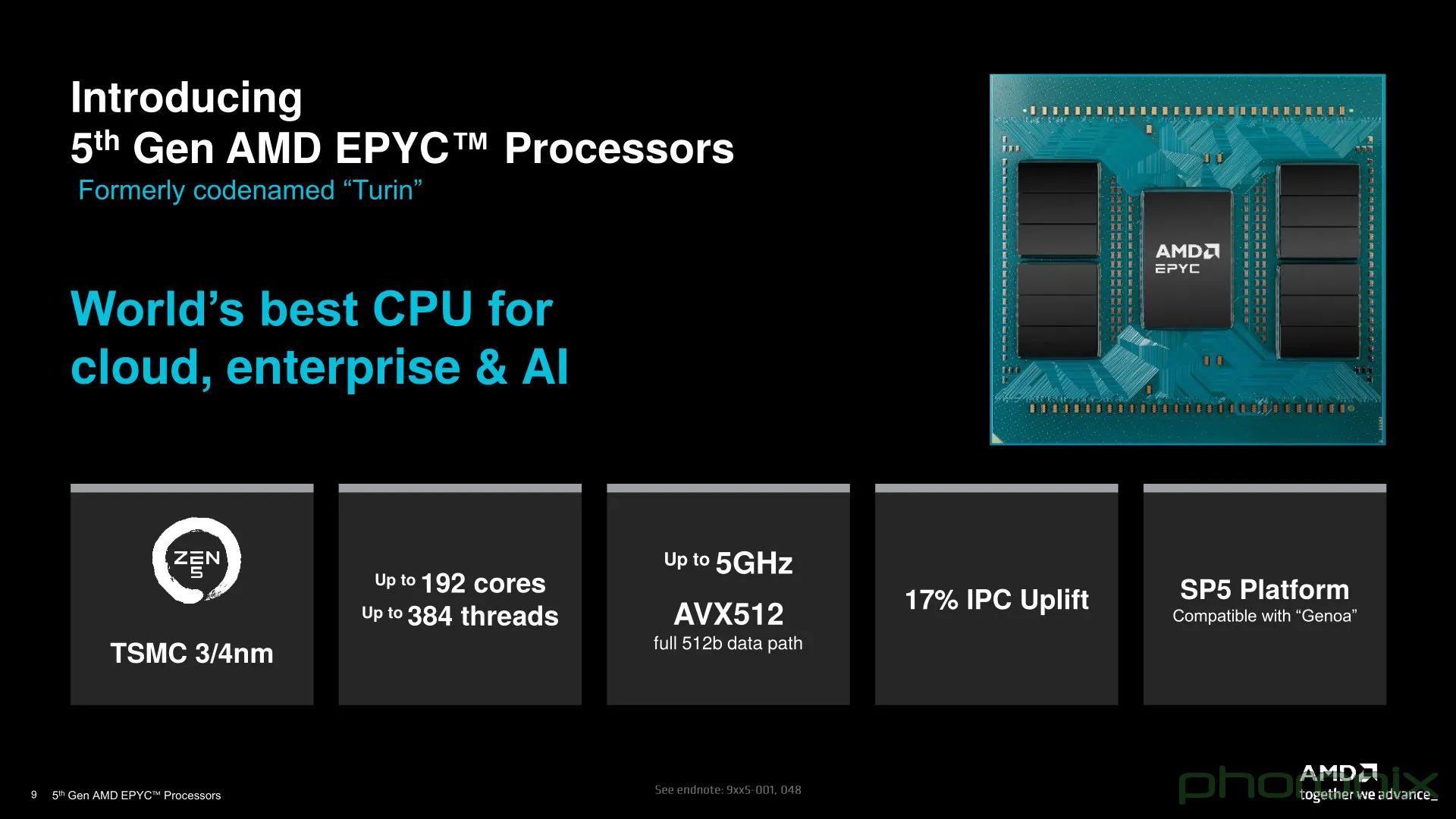We’re excited to announce the addition of new Servers to our lineup, powered by the latest AMD EPYC Turin processors. These 5th generation EPYC CPUs represent a significant leap forward in server technology. They offer unprecedented core counts, enhanced performance, and superior energy efficiency – all at exceptional Artyvision value.
Available since the AMD Turin release date in October 2024, these new processors feature AMD’s advanced Zen 5 architecture. The new chips deliver improvements across all performance metrics that matter most for real-world workloads. Whether you’re running demanding databases, scaling ecommerce platforms, or deploying AI inference workloads, our new Turin-powered Servers provide the foundation you need.
Let’s find out what makes these processors special and how they can transform your projects.
Understanding AMD EPYC: The Technology Behind the Power
When we talk about server processors, not all CPUs are created equal. AMD EPYC architecture represents a fundamentally different approach to server computing – one built around efficiency, scalability, and modern workloads.
For those less familiar with the EPYC lineup, what is AMD EPYC? It’s AMD’s flagship server processor family, designed specifically for data center and enterprise computing needs. The EPYC series offers exceptional multi-core performance with advanced security features built directly into the hardware.
At its core, the AMD EPYC processor family uses a chiplet-based design that allows for exceptional flexibility and performance scaling. Rather than creating a single monolithic die, AMD connects multiple smaller chips together. This approach delivers advantages in manufacturing yield, thermal management, and performance distribution.
The latest AMD Turin architecture takes this approach even further. Built on cutting-edge 3nm and 4nm manufacturing processes (depending on the specific model), Turin processors feature AMD’s new Zen 5 cores. These cores offer a significant 17% increase in instructions per clock (IPC) over the previous generation. This means more work done in each CPU cycle – a direct benefit for virtually every server workload.
What truly sets the AMD server CPU apart is its balance of raw performance, energy efficiency, and value. With support for 12-channel DDR5-6400 memory, and 128 PCIe 5.0 lanes, these processors provide optimized resources for today’s most demanding workloads.
Evolution of Processing Power: Turin vs. Previous Generations
To fully appreciate what Turin brings to the table, it’s helpful to understand how it compares to previous EPYC generations. The progression from AMD Genoa to Turin represents a significant leap forward in processing capabilities.
The previous generation, AMD EPYC Genoa, was already impressive with up to 96 cores using Zen 4 architecture. Turin builds on this foundation with the new Zen 5 cores, offering that 17% IPC improvement we mentioned earlier. This means better performance even at the same core count and frequency. According to official AMD benchmarks, Turin consistently outperforms Genoa CPUs, achieving approximately 2x higher throughput in most configurations, particularly when running AI and machine learning workloads.
But Turin doesn’t just improve performance – it also expands the maximum core count. While the Genoa series topped out at 96 cores per socket, Turin scales up to 192 cores with its density-optimized Zen 5c cores. This represents a 2x increase in maximum core density, delivering unprecedented computational capacity in a single socket.
Memory capabilities have also evolved. While both generations support 12 channels of DDR5, Turin increases the maximum supported memory speed to DDR5-6400 on qualified platforms, up from DDR5-6000 in Genoa. This might seem like an incremental improvement, but for memory-bandwidth-intensive applications, it can make a meaningful difference in overall performance.
What’s particularly impressive about the Turin architecture is how it achieves these improvements while maintaining reasonable power consumption. Despite the increased core count and performance, Turin processors feature similar TDP ratings to their Genoa predecessors, with most models falling between 200W and 400W.
Competitive Landscape: AMD vs. Intel in Server Computing
When evaluating server processors, it’s natural to compare different options. The AMD EPYC vs Intel Xeon comparison is particularly relevant for those making infrastructure decisions.
In today’s landscape, AMD EPYC vs Xeon benchmarks consistently show AMD’s advantage in core count, memory bandwidth, and PCIe connectivity. While Intel’s latest Xeon processors offer competitive single-thread performance, the multi-threaded performance gap has widened with Turin’s release.
The AMD server market share has grown significantly in recent years precisely because of these advantages. AMD’s official benchmarks show the EPYC 9755 Turin processor outperforms Intel’s dual Xeon Granite Rapids 6980P by about 40% on average across various workloads. AMD also reports that the EPYC 9965 CPU can deliver up to 3.7x the performance on end-to-end AI workloads compared to competitors, with 1.9x throughput improvements on certain generative AI models. These metrics highlight the strength of the Turin series across a range of essential tasks.
Experience AMD Turin Power Today
By bringing the latest AMD server technology to our platform at accessible price points, we’re enabling businesses of all sizes to access enterprise-grade computing power for their projects.
Ready to experience the power of AMD EPYC Turin? The future of high-performance computing is here, and it’s more accessible than ever. Explore our new Turin-powered Servers today and discover what this cutting-edge technology can do for your projects.







